Effect of the Temperature on the Magnetic and Energetic Properties of Soft Magnetic Composite Materials
Abstract
:1. Introduction
2. Phenomenon Description and Procedure
2.1. Specimen Preparation
2.2. Experimental Procedure
3. Experimental Results
3.1. BH Curves
3.2. Maximum Magnetic Permeability
3.3. Hysteresis Cycles
3.4. Specific Iron Losses
4. Conclusions
Author Contributions
Funding
Institutional Review Board Statement
Informed Consent Statement
Data Availability Statement
Conflicts of Interest
References
- Bureš, R.; Strečkova, M.; Faberova, M.; Kollar, P.; Fuzer, J. Advances in powder metallurgy soft magnetic composite materials. Arch. Met. Mater. 2017, 62, 1149–1154. [Google Scholar] [CrossRef] [Green Version]
- Sunday, K.J.; Taheri, M.L. Soft magnetic composites: Recent advancements in the technology. Met. Powder Rep. 2017, 72, 425–429. [Google Scholar] [CrossRef]
- Périgo, E.A.; Weidenfeller, B.; Kollár, P.; Füzer, J. Past, present and future of soft magnetic composites. Appl. Phys. Rev. 2018, 5, 031301. [Google Scholar] [CrossRef]
- Zhao, G.; Wu, C.; Yan, M. Enhanced magnetic properties of Fe soft magnetic composites by surface oxidation. J. Magn. Magn. Mater. 2016, 399, 51–57. [Google Scholar] [CrossRef]
- Sunday, K.J.; Hanejko, F.G.; Taheri, M.L. Magnetic and microstructural properties of Fe3O4-coated Fe powder soft magnetic composites. J. Magn. Magn. Mater. 2017, 423, 164–170. [Google Scholar] [CrossRef]
- Füzer, J.; Strečková, M.; Dobák, S.; Ďáková, Ľ.; Kollár, P.; Fáberová, M.; Bureš, R.; Osadchuk, Y.; Kurek, P.; Vojtko, M. Innovative ferrite nanofibres reinforced soft magnetic composite with enhanced electrical resistivity. J. Alloys Compd. 2018, 753, 219–227. [Google Scholar] [CrossRef]
- Yaghtin, M.; Taghvaei, A.H.; Hashemi, B.; Janghorban, K. Effect of heat treatment on magnetic properties of iron-based soft magnetic composites with Al2O3 insulation coating produced by sol–gel method. J. Alloys Compd. 2013, 581, 293–297. [Google Scholar] [CrossRef]
- Luo, F.; Fan, X.; Luo, Z.; Hu, W.; Wang, J.; Wu, Z.; Li, G.; Li, Y.; Liu, X. Preparation and magnetic properties of FeSiAl-based soft magnetic composites with MnO/Al2O3 insulation layer. J. Magn. Magn. Mater. 2020, 498, 166084. [Google Scholar] [CrossRef]
- Bidulský, R.; Bidulská, J.; Grande, M.A.; Ferraris, L. Aluminium alloy addition effects on the behaviour of soft magnetic materials at low frequencies. Acta Metall. Slovaca 2014, 20, 271–278. [Google Scholar] [CrossRef] [Green Version]
- Zhou, B.; Dong, Y.; Liu, L.; Chang, L.; Bi, F.; Wang, X. Enhanced soft magnetic properties of the Fe-based amorphous powder cores with novel TiO2 insulation coating layer. J. Magn. Magn. Mater. 2019, 474, 1–8. [Google Scholar] [CrossRef]
- Yan, L.; Yan, B. Fe-Si/MnZn(Fe2O4)2 Core-shell Composites with Excellent Magnetic Properties by Mechanical Milling and Spark Plasma Sintering (SPS). Metals 2018, 8, 553. [Google Scholar] [CrossRef] [Green Version]
- Wu, Z.; Fan, X.; Wang, J.; Li, G.; Gan, Z.; Zhang, Z. Core loss reduction in Fe–6.5wt.%Si/SiO2 core–shell composites by ball milling coating and spark plasma sintering. J. Alloys Compd. 2014, 617, 21–28. [Google Scholar] [CrossRef]
- Luo, Z.; Fan, X.; Hu, W.; Luo, F.; Wang, J.; Wu, Z.; Liu, X.; Li, G.; Li, Y. High performance Fe-Si soft magnetic composites coated with novel insulating-magnetic-insulating (IMI) layer. J. Magn. Magn. Mater. 2020, 496, 165937. [Google Scholar] [CrossRef]
- Pošković, E.; Ferraris, L.; Franchini, F.; Bidulsky, R.; Actis Grande, M. Novel SMC Materials with the Insulating Layer Treated at High Temperature. In Proceedings of the EPMA Euro PM2019, Maastricht, The Netherlands, 13–16 October 2019; European Powder Metallurgy Association: Chantilly, France, 2019. [Google Scholar]
- Zheng, J.; Zheng, H.; Lei, J.; Qiao, L.; Ying, Y.; Cai, W.; Li, W.; Yu, J.; Liu, Y.; Huang, X.; et al. Structure and magnetic properties of Fe-based soft magnetic composites with an Li–Al–O insulation layer obtained by hydrothermal synthesis. J. Alloys Compd. 2020, 816, 152617. [Google Scholar] [CrossRef]
- Actis Grande, M.; Bidulský, R.; Cavagnino, A.; Ferraris, L.; Ferraris, P. Investigations on different processing conditions on softmagnetic composite material behavior al low frequency. IEEE Trans. Ind. Appl. 2012, 48, 1335–1343. [Google Scholar] [CrossRef]
- Dias, M.M.; Mozetic, H.J.; Barboza, J.S.; Martins, R.M.; Pelegrini, L.; Schaeffer, L. Influence of resin type and content on electrical and magnetic properties of soft magnetic composites (SMCs). Powder Technol. 2013, 237, 213–220. [Google Scholar] [CrossRef]
- Ferraris, L.; Pošković, E.; Franchini, F. New soft magnetic composites for electromagnetic applications with improved mechanical properties. AIP Adv. 2016, 6, 056209. [Google Scholar] [CrossRef] [Green Version]
- Taghvaei, A.H.; Shokrollahi, H.; Janghorban, K. Magnetic and structural properties of iron phosphate–phenolic soft magnetic composites. J. Magn. Magn. Mater. 2009, 321, 3926–3932. [Google Scholar] [CrossRef]
- Streckova, M.; Bures, R.; Faberova, M.; Medvecky, L.; Fuzer, J.; Kollar, P. A comparison of soft magnetic composites designed from different ferromagnetic powders and phenolic resins. Chin. J. Chem. Eng. 2015, 23, 736–743. [Google Scholar] [CrossRef]
- Taghvaei, A.H.; Shokrollahi, H.; Ghaffari, M.; Janghorban, K. Influence of particle size and compaction pressure on the magnetic properties of iron-phenolic soft magnetic composites. J. Phys. Chem. Solids 2010, 71, 7–11. [Google Scholar] [CrossRef]
- Kollár, P.; Birčáková, Z.; Vojtek, V.; Füzer, J.; Bureš, R.; Fáberová, M. Dependence of demagnetizing fields in Fe-based composite materials on magnetic particle size and the resin content. J. Magn. Magn. Mater. 2015, 388, 76–81. [Google Scholar] [CrossRef]
- Luo, D.; Wu, C.; Yan, M. Incorporation of the Fe3O4 and SiO2 nanoparticles in epoxy-modified silicone resin as the coating for soft magnetic composites with enhanced performance. J. Magn. Magn. Mater. 2018, 452, 5–9. [Google Scholar] [CrossRef]
- Birčáková, Z.; Füzer, J.; Kollár, P.; Streckova, M.; Szabó, J.; Bureš, R.; Fáberová, M. Magnetic properties of Fe-based soft magnetic composite with insulation coating by resin bonded Ni-Zn ferrite nanofibres. J. Magn. Magn. Mater. 2019, 485, 1–7. [Google Scholar] [CrossRef]
- Meng, B.; Yang, B.; Zhang, X.; Zhou, B.; Li, X.; Yu, R. Combinatorial surface coating and greatly-improved soft magnetic performance of Fe/Fe3O4/resin composites. Mater. Chem. Phys. 2020, 242, 122478. [Google Scholar] [CrossRef]
- Poskovic, E.; Franchini, F.; Grande, M.A.; Ferraris, L.; Bidulsky, R. Innovative Soft Magnetic Composite Materials: Evaluation of magnetic and mechanical properties. De Gruyter Open Eng. 2018, 8, 368–372. [Google Scholar] [CrossRef]
- Zhou, B.; Chi, Q.; Dong, Y.; Liu, L.; Zhang, Y.; Chang, L.; Pan, Y.; He, A.; Li, J.; Wang, X. Effects of annealing on the magnetic properties of Fe-based amorphous powder cores with inorganic-organic hybrid insulating layer. J. Magn. Magn. Mater. 2020, 494, 165827. [Google Scholar] [CrossRef]
- Grande, M.A.; Ferraris, L.; Franchini, F.; Pošković, E. New SMC materials for small electrical machine with very good mechanical properties. IEEE Trans. On Ind. Appl. 2018, 54, 195–203. [Google Scholar] [CrossRef]
- Khan, M.A.; Chen, Y.; Pillay, P. Application of soft magnetic composites to PM wind generator design. In Proceedings of the IEEE Power Engineering Society General Meeting, Montreal, QC, Canada, 18–22 June 2006; pp. 1–4. [Google Scholar] [CrossRef]
- Schoppa, A.; Delarbre, P.; Schatz, A. Optimal Use of soft magnetic powder composite (SMC) in Electric Machines. In Proceedings of the MPIF PowderMet, Chicago, IL, USA, 24–27 June 2013; pp. 10-130–10-139. [Google Scholar]
- Cros, J.; Perin, A.J.; Viarouge, P. Soft magnetic composites for electromagnetic components in lighting applications. In Proceedings of the IEEE IAS Annual Meeting, Pittsburgh, PA, USA, 13–18 October 2002; pp. 342–347. [Google Scholar]
- Ferraris, L.; Poskovic, E.; Franchini, F.; Grande, M.A.; Bianchi, N. New magnetic materials in the electrical machines: Development and applications. In Proceedings of the EPMA EURO PM2017, Milan, Italy, 1–5 October 2017. [Google Scholar]
- Kącki, M.; Rylko, M.S.; Hayes, J.G.; Sullivan, C.R. Magnetic material selection for EMI filters. In Proceedings of the IEEE ECCE Conference, Cincinnati, OH, USA, 1–5 October 2017; pp. 2350–2356. [Google Scholar] [CrossRef]
- Silveyra, J.M.; Ferrara, E.; Huber, D.L.; Monson, T.C. Soft magnetic materials for a sustainable and electrified world. Science 2018, 362, 1–9. [Google Scholar] [CrossRef] [PubMed] [Green Version]
- Gheiratmand, T.; Hosseini, H.R.M.; Reihani, S.M.S. Iron-borosilicate soft magnetic composites: The correlation between processing parameters and magnetic properties for high frequency applications. J. Magn. Magn. Mater. 2017, 429, 241–250. [Google Scholar] [CrossRef] [Green Version]
- Wu, Z.Y.; Jiang, Z.; Fan, X.A.; Zhou, L.J.; Wang, W.L.; Xu, K. Facile synthesis of Fe-6.5wt%Si/SiO2 soft magnetic composites as an efficient soft magnetic composite material at medium and high frequencies. J. Alloys Compd. 2018, 742, 90–98. [Google Scholar] [CrossRef]
- Schoppa, A.; Delarbre, P.; Holzmann, E.; Sigl, M. Magnetic properties of soft magnetic powder composites at higher frequencies in comparison with electrical steels. In Proceedings of the IEEE EDPC Conference, Nuremberg, Germany, 29–30 October 2013; pp. 1–5. [Google Scholar]
- Liew, G.S.; Ertugrul, N.; Soong, W.L.; Gehlert, D.B. Analysis and Performance Evaluation of an Axial-Field Brushless PM Machine Utilising Soft Magnetic Composites. In Proceedings of the IEEE IEMDC Conference, Antalya, Turkey, 3–5 May 2007; pp. 153–158. [Google Scholar]
- Franchini, F.; Poskovic, E.; Ferraris, L.; Cavagnino, A.; Bramerdorfer, G. Application of new magnetic materials for axial flux machine prototypes. In Proceedings of the IEEE IEMDC Conference, Miami, FL, USA, 21–24 May 2017; pp. 1–6. [Google Scholar]
- Chang, J.; Lee, J.; Kim, J.; Chung, S.; Kang, D.; Weh, H. Development of Rotating Type Transverse Flux Machine. In Proceedings of the IEEE IEMDC Conference, Antalya, Turkey, 3–5 May 2007; pp. 1090–1095. [Google Scholar]
- Zhu, J.G.; Guo, Y.G.; Lin, Z.W.; Li, Y.J.; Huang, Y.K. Development of PM Transverse Flux Motors With Soft Magnetic Composite Cores. IEEE Trans. Magn. 2011, 47, 4376–4383. [Google Scholar] [CrossRef]
- Doering, J.; Steinborn, G.; Hofmann, W. Torque, Power, Losses, and Heat Calculation of a Transverse Flux Reluctance Machine With Soft Magnetic Composite Materials and Disk-Shaped Rotor. IEEE Trans. On Ind. Appl. 2015, 51, 1494–1504. [Google Scholar] [CrossRef]
- Passenbrunner, J.; Andessner, D.; Kobler, R.; Amrhein, W. Modeling, simulation and design of a claw pole machine using soft magnetic composites. In Proceedings of the IEEE VPPC Conference, Chicago, IL, USA, 6–9 September 2011; pp. 1–6. [Google Scholar]
- Maurus, Q.; Löffler, C.; Canders, W. New linear drive concepts by taking advantage of Soft Magnetic Composites (SMC). In Proceedings of the IEEE EPE-PEMC Conference, Ohrid, Macedonia, 6–8 September 2010; pp. S3-21–S3-28. [Google Scholar]
- Nord, G.; Jansson, P.; Petersen, C.C.; Yamada, T. Vertical electrical motor using soft magnetic composites. In Proceedings of the IEEE IEMDC Conference, San Antonio, TX, USA, 15 May 2005; pp. 373–377. [Google Scholar]
- Pošković, E.; Ferraris, L.; Franchini, F.; Cavagnino, A.; Grande, M.A. SMC Materials in Electrical Machine Prototypes. In Proceedings of the IEEE IEMDC Conference, San Diego, CA, USA, 12–15 May 2019; pp. 2042–2047. [Google Scholar]
- Fiorillo, F.; Appino, C.; Pasquale, M. Chapter 1—Hysteresis in Magnetic Materials. In The Science of Hysteresis; Bertotti, G., Mayergoyz, I., Eds.; Academic Press: Cambridge, MA, USA, 2006; Volume III, pp. 1–190. [Google Scholar]
- Bertotti, G.; Fiorillo, F.; Montorsi, A. The role of grain size in the magnetization process of soft magnetic materials. AIP J. Appl. Phys. 1990, 67, 5574–5576. [Google Scholar] [CrossRef]
- Pan, Y.; Peng, J.; Qian, L.; Xiang, Z.; Lu, W. Effects of compaction and heat treatment on the soft magnetic properties of iron-based soft magnetic composites. Mater. Res. Express 2020, 7, 016115. [Google Scholar] [CrossRef]
- Oikonomou, C.; Hryha, E.; Nyborg, L. An XPS investigation on the thermal stability of the insulating surface layer of soft magnetic composite powder. ECASIA J. Surf. Interface Anal. 2016, 48, 445–450. [Google Scholar] [CrossRef]
- Ferraris, L.; Franchini, F.; Poskovic, E. Overview of SMC characterization for their adoption in electromechanical systems. In Proceedings of the 9th International Conference on Magnetism and Metallurgy (WMM 2020), Rome, Italy, 3–5 November 2020; pp. 75–91. [Google Scholar]
- Lauda, M.; Füzer, J.; Kollár, P.; Strečková, M.; Bureš, R.; Kováč, J.; Baťková, M.; Baťko, I. Magnetic properties and loss separation in FeSi/MnZnFe2O4 soft magnetic composites. J. Magn. Magn. Mater. 2016, 411, 12–17. [Google Scholar] [CrossRef]
- Dobák, S.; Füzer, J.; Kollár, P.; Fáberová, M.; Bureš, R. Interplay of domain walls and magnetization rotation on dynamic magnetization process in iron/polymer–matrix soft magnetic composites. J. Magn. Magn. Mater. 2017, 426, 320–327. [Google Scholar] [CrossRef]
- Anhalt, M.; Weidenfeller, B. Dynamic losses in FeSi filled polymer bonded soft magnetic composites. J. Magn. Magn. Mater. 2006, 304, e549–e551. [Google Scholar] [CrossRef]
- Taghvaei, A.H.; Shokrollahi, H.; Janghorban, K.; Abiri, H. Eddy current and total power loss separation in the iron–phosphate–polyepoxy soft magnetic composites. Mater. Des. 2009, 30, 3989–3995. [Google Scholar] [CrossRef]
- De la Barriere, O.; Appino, C.; Fiorillo, F.; Ragusa, C.; Lecrivain, M.; Rocchino, L.; Ahmed, H.B.; Gabsi, M.; Mazaleyrat, F.; LoBue, M. Characterization and Prediction of Magnetic Losses in Soft Magnetic Composites Under Distorted Induction Waveform. IEEE Trans. Magn. 2013, 49, 1318–1326. [Google Scholar] [CrossRef] [Green Version]
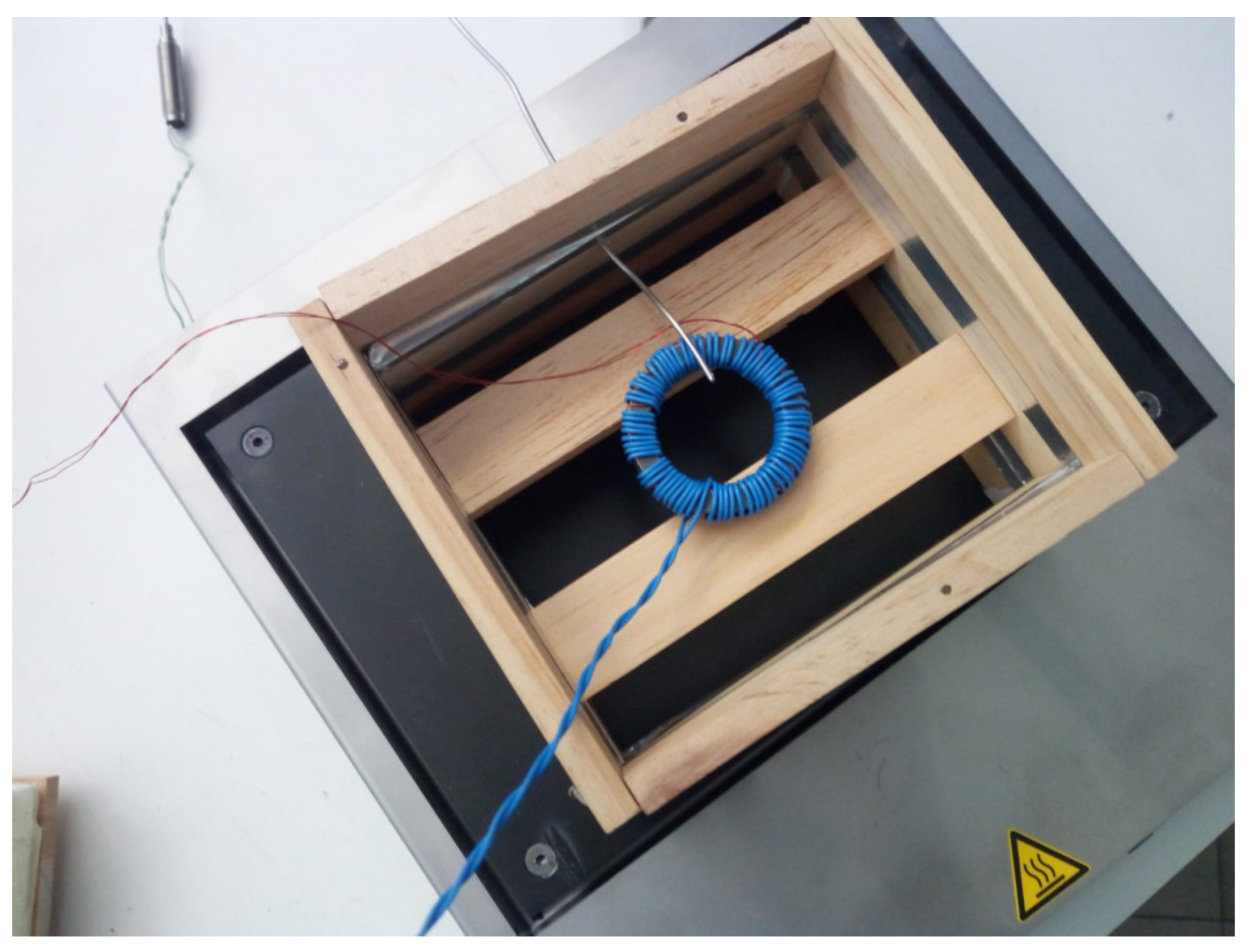
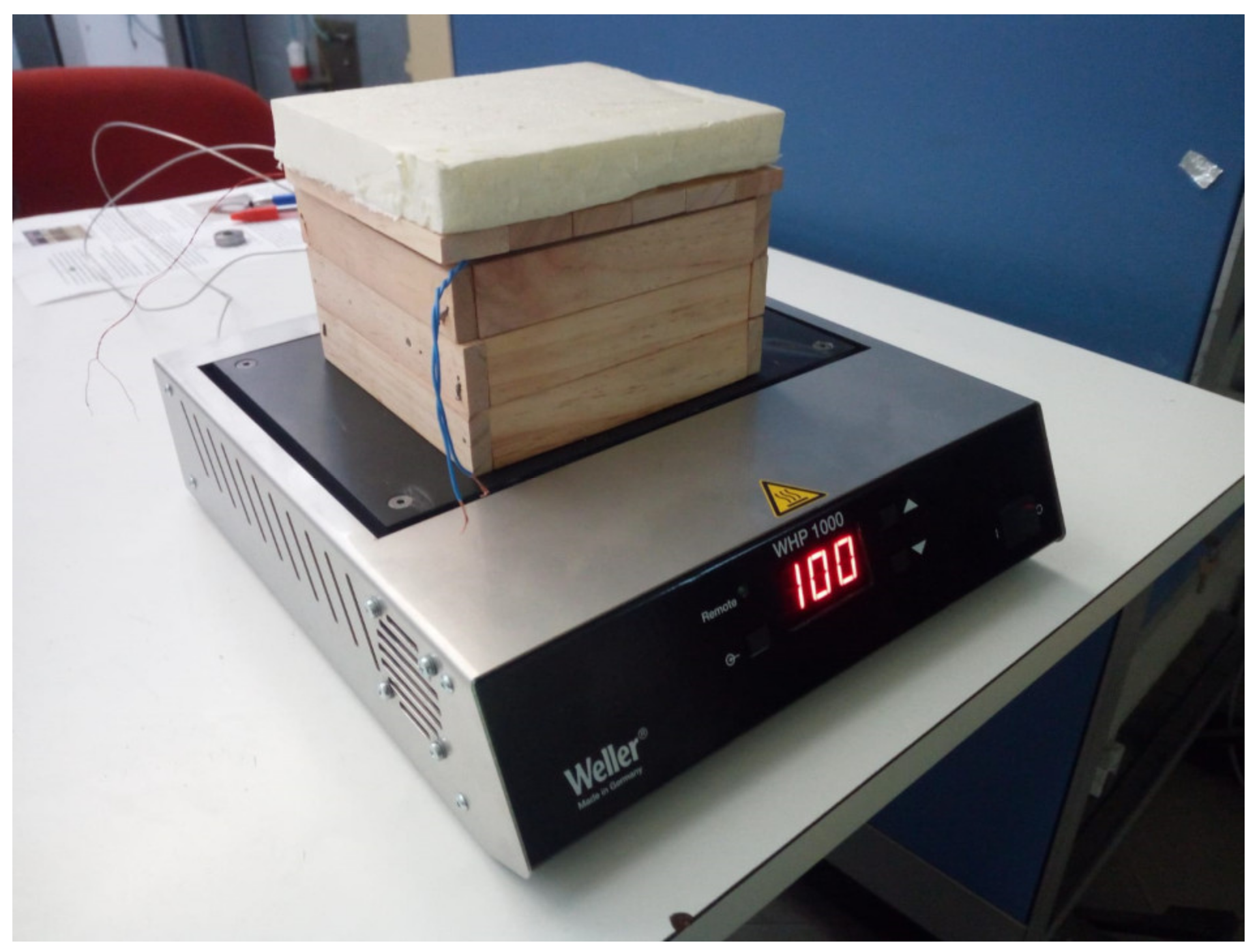
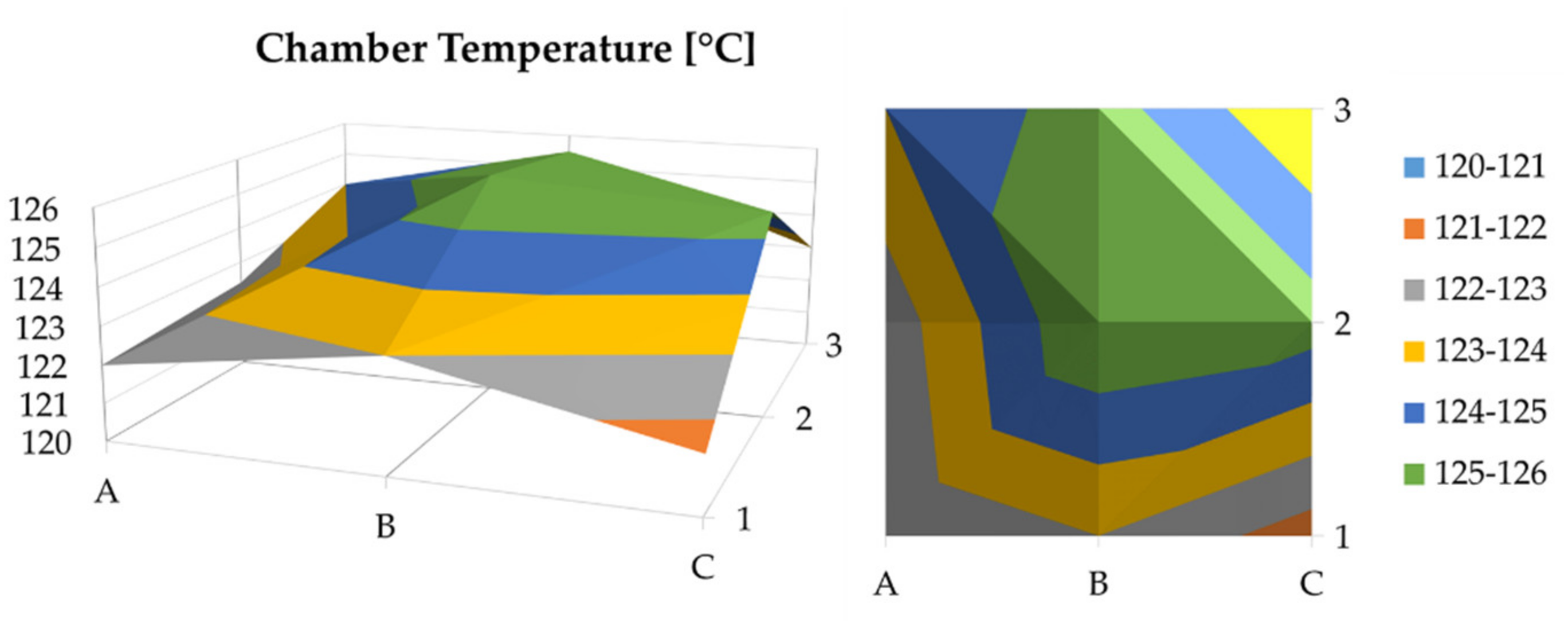
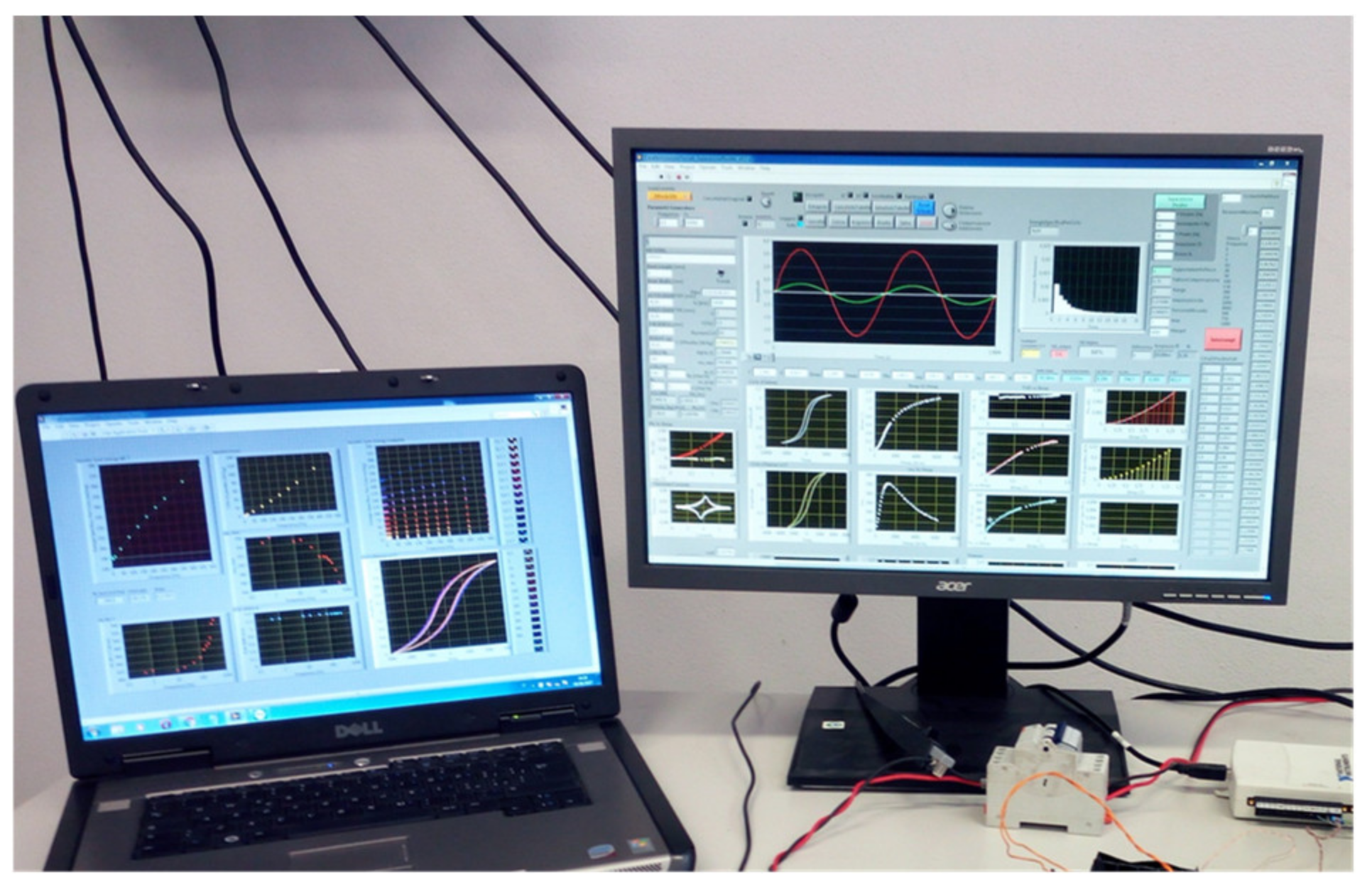
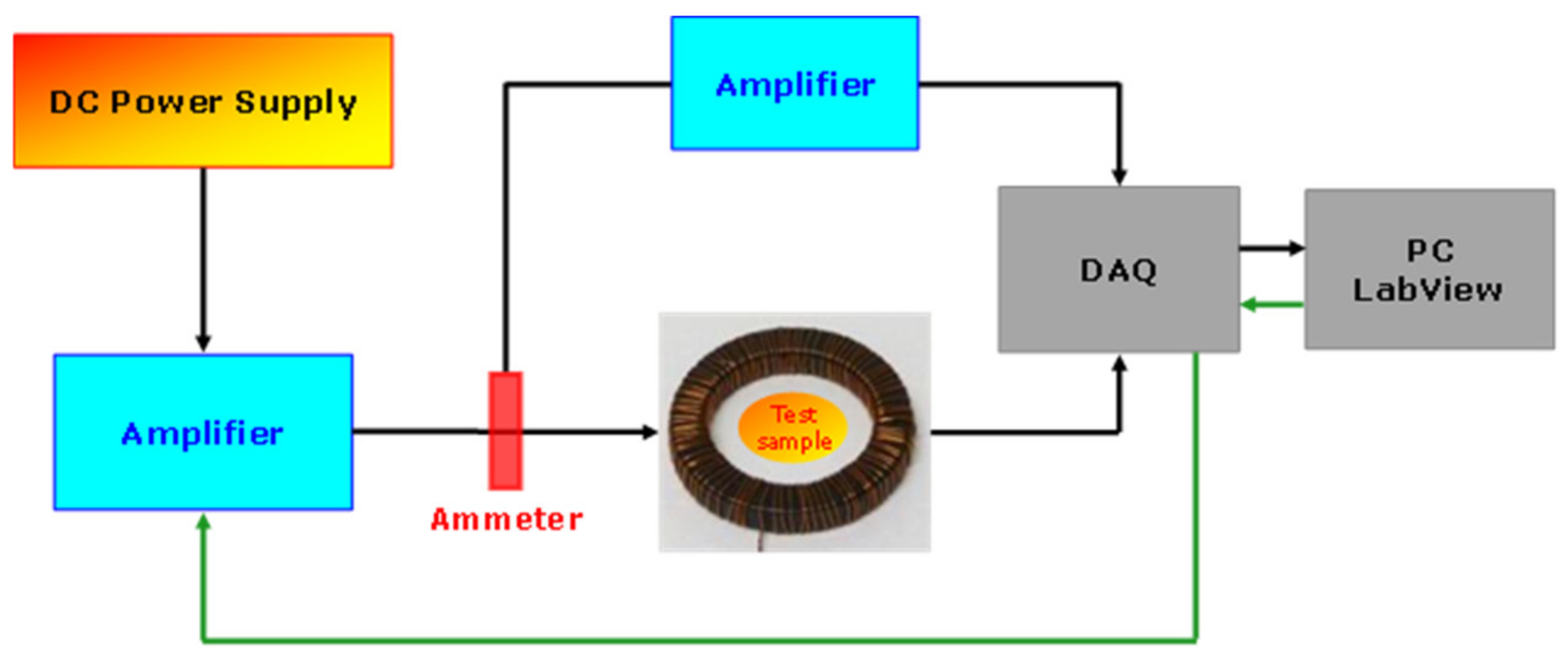
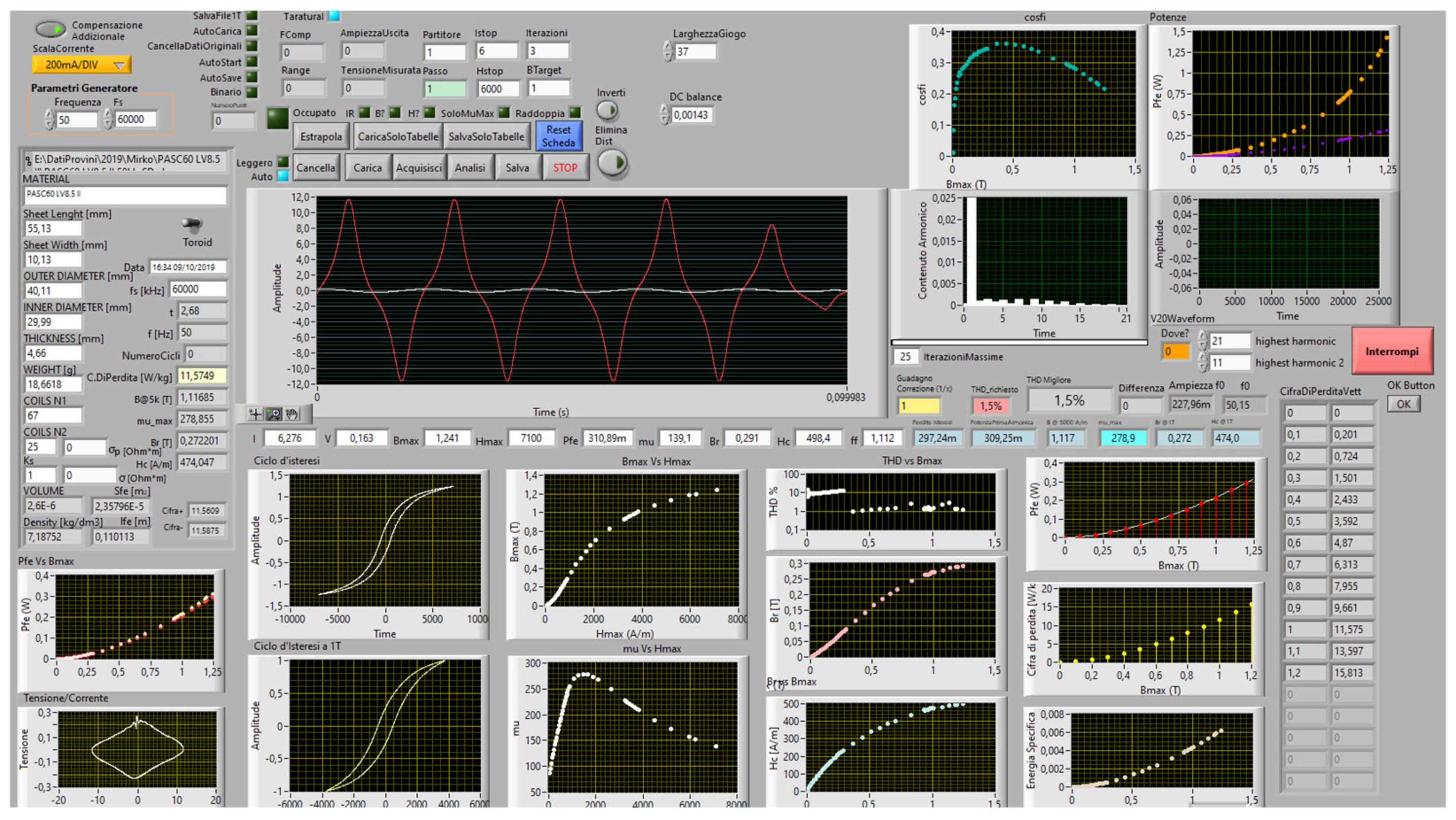
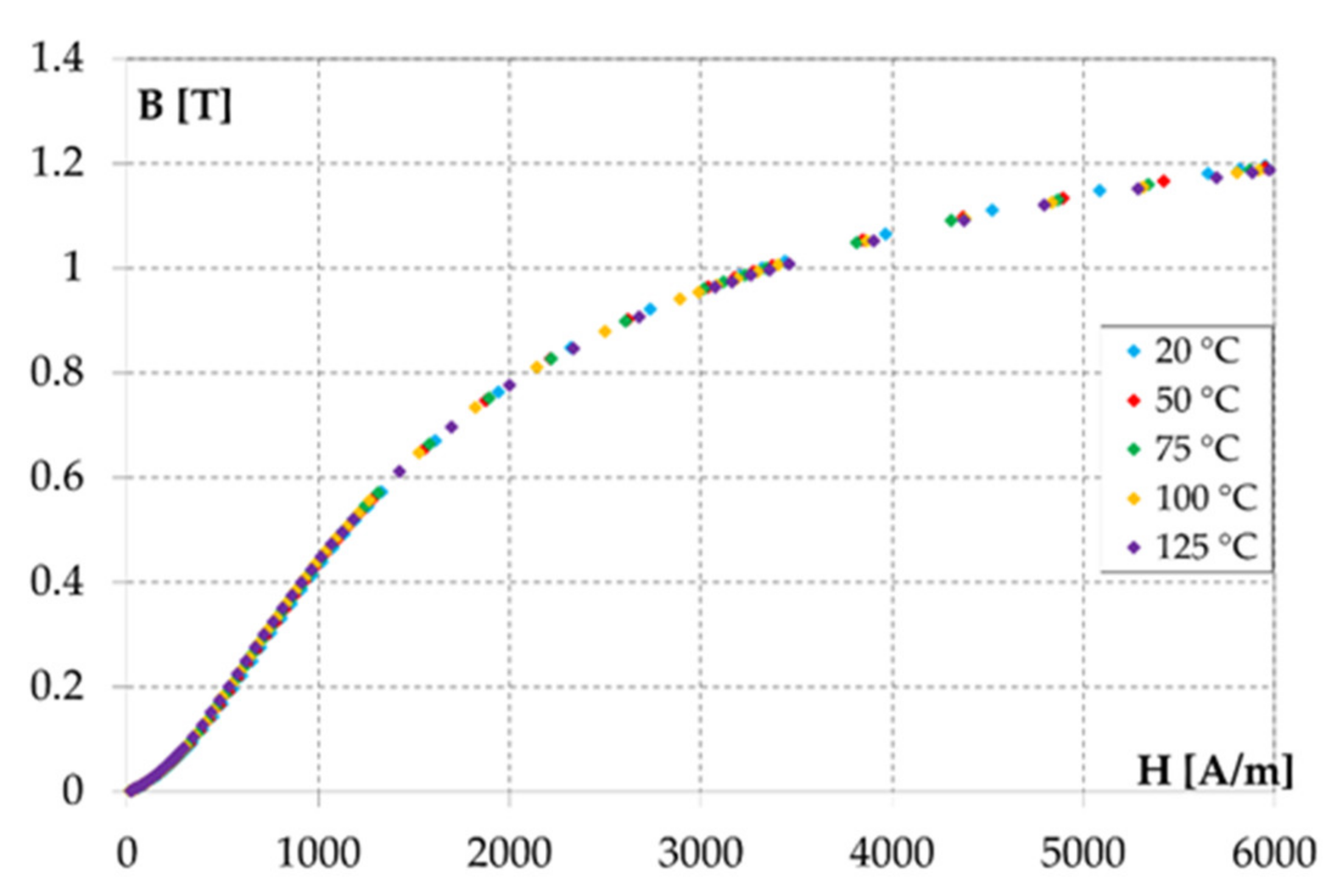
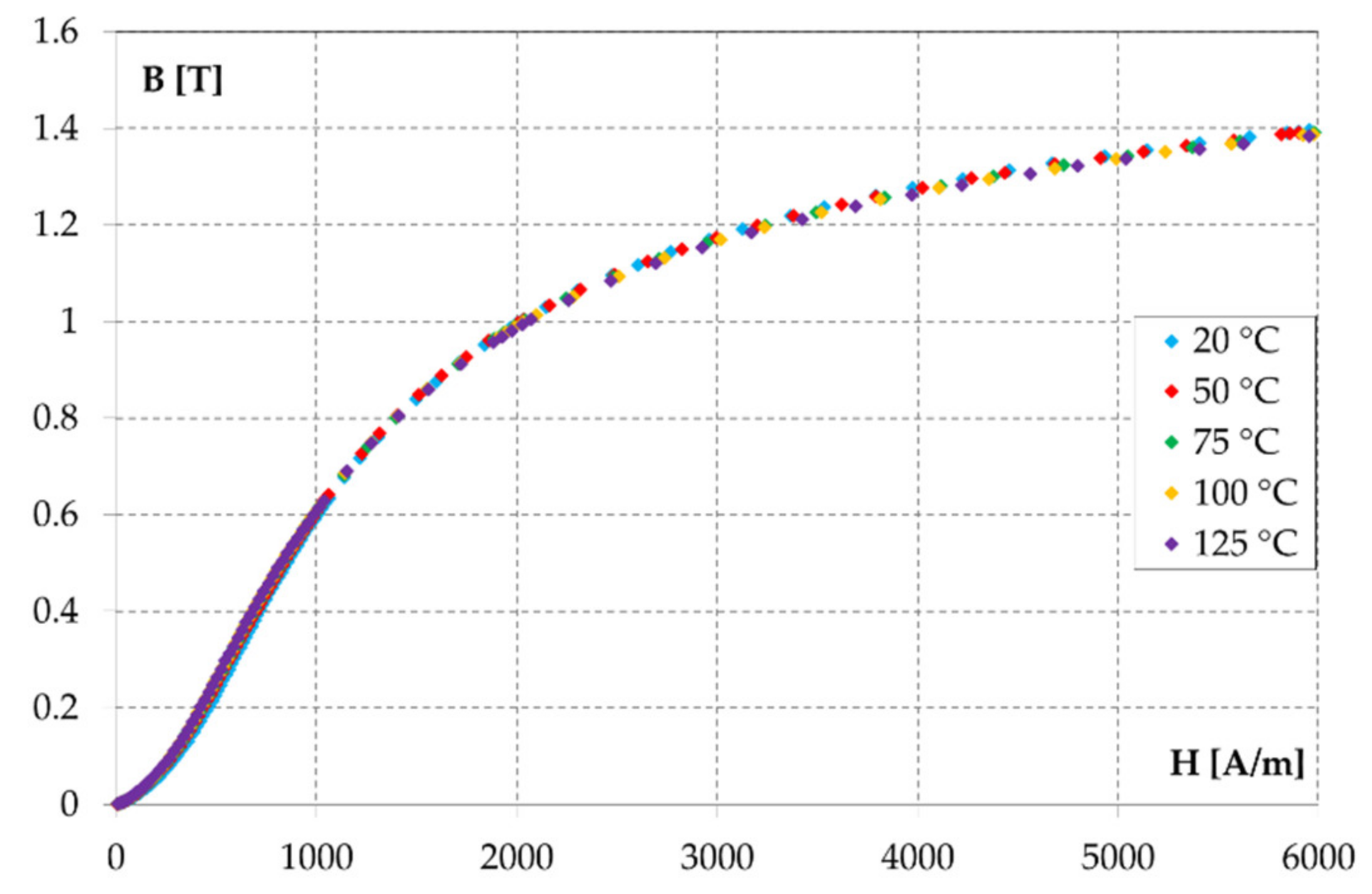
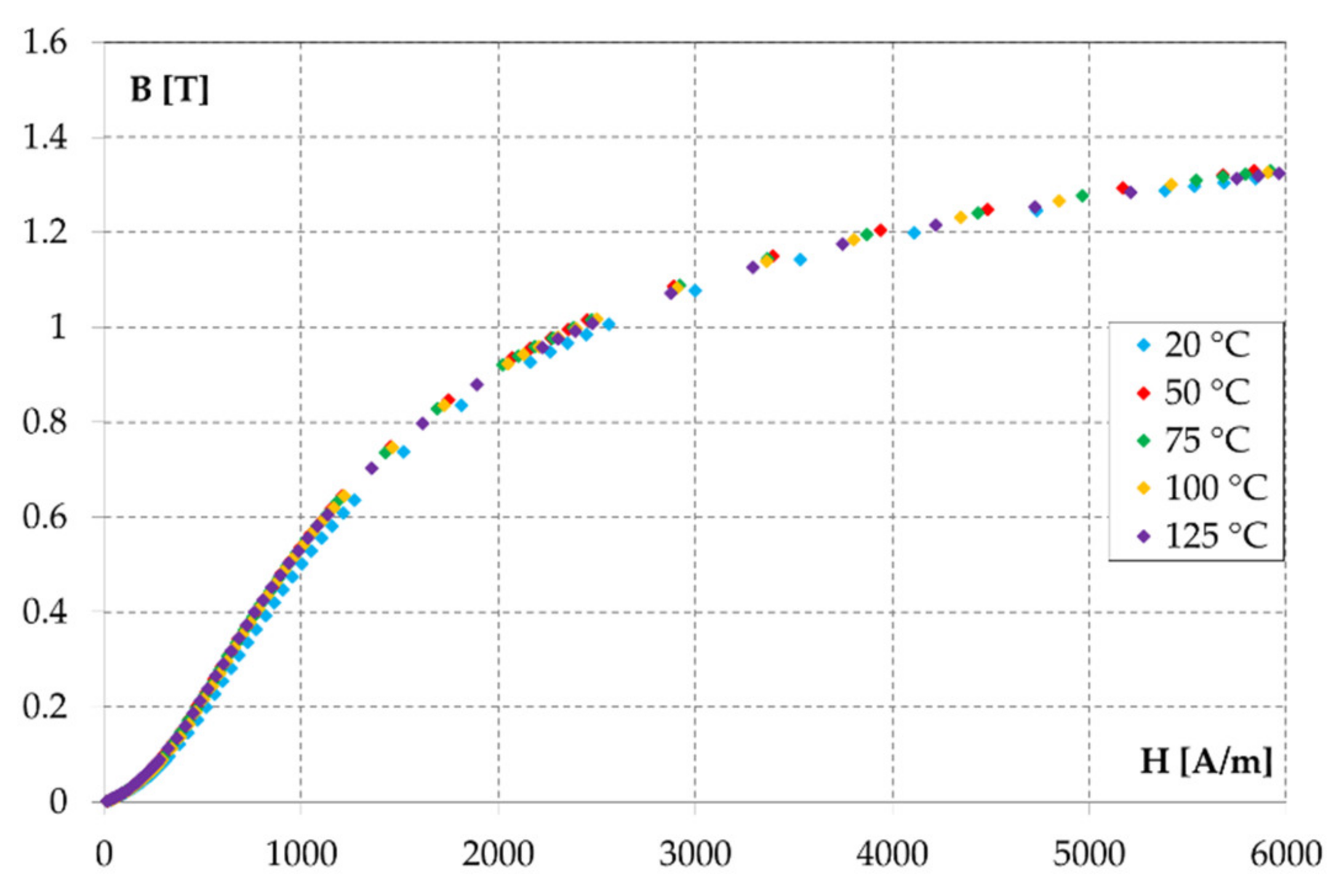
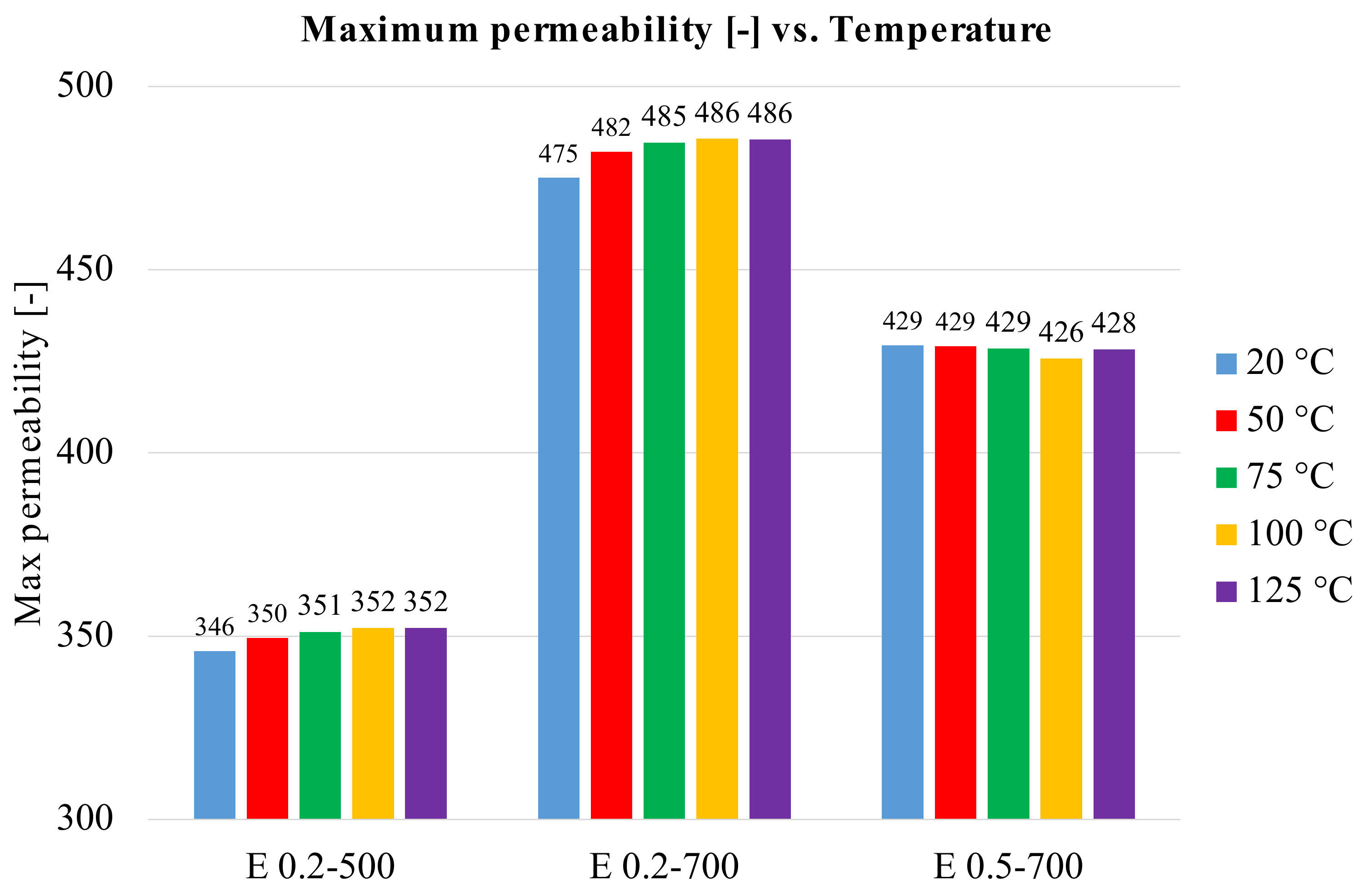
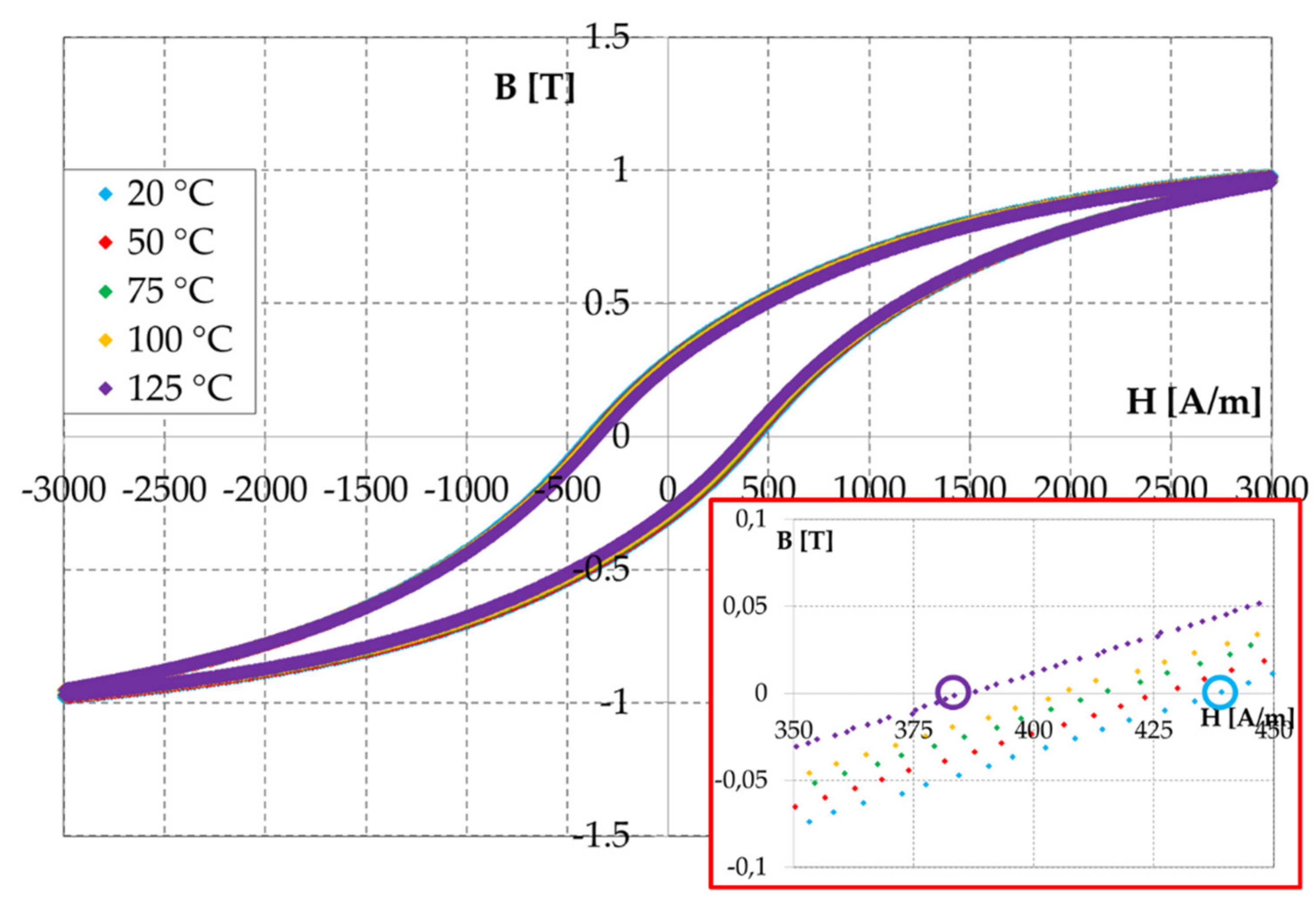

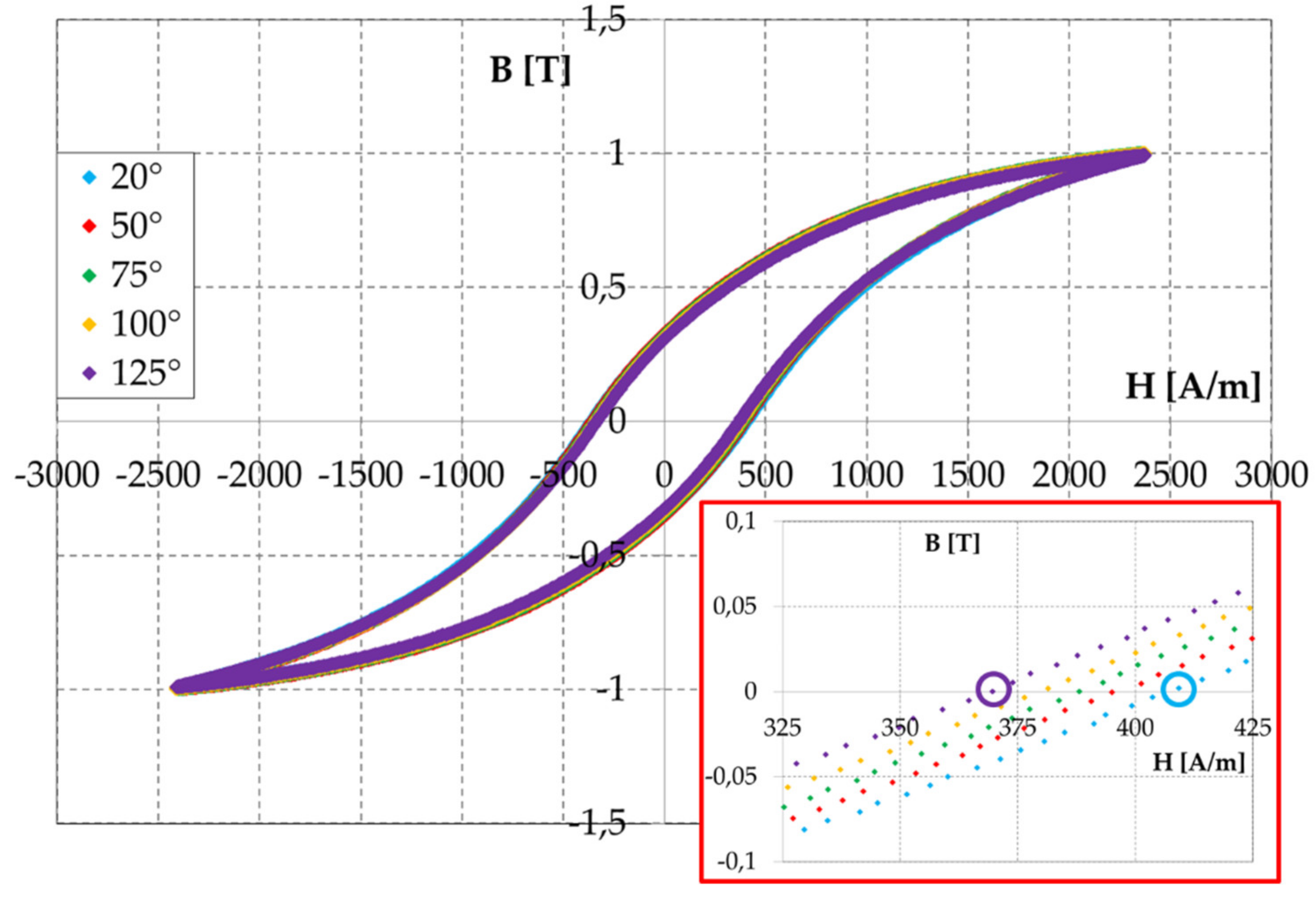
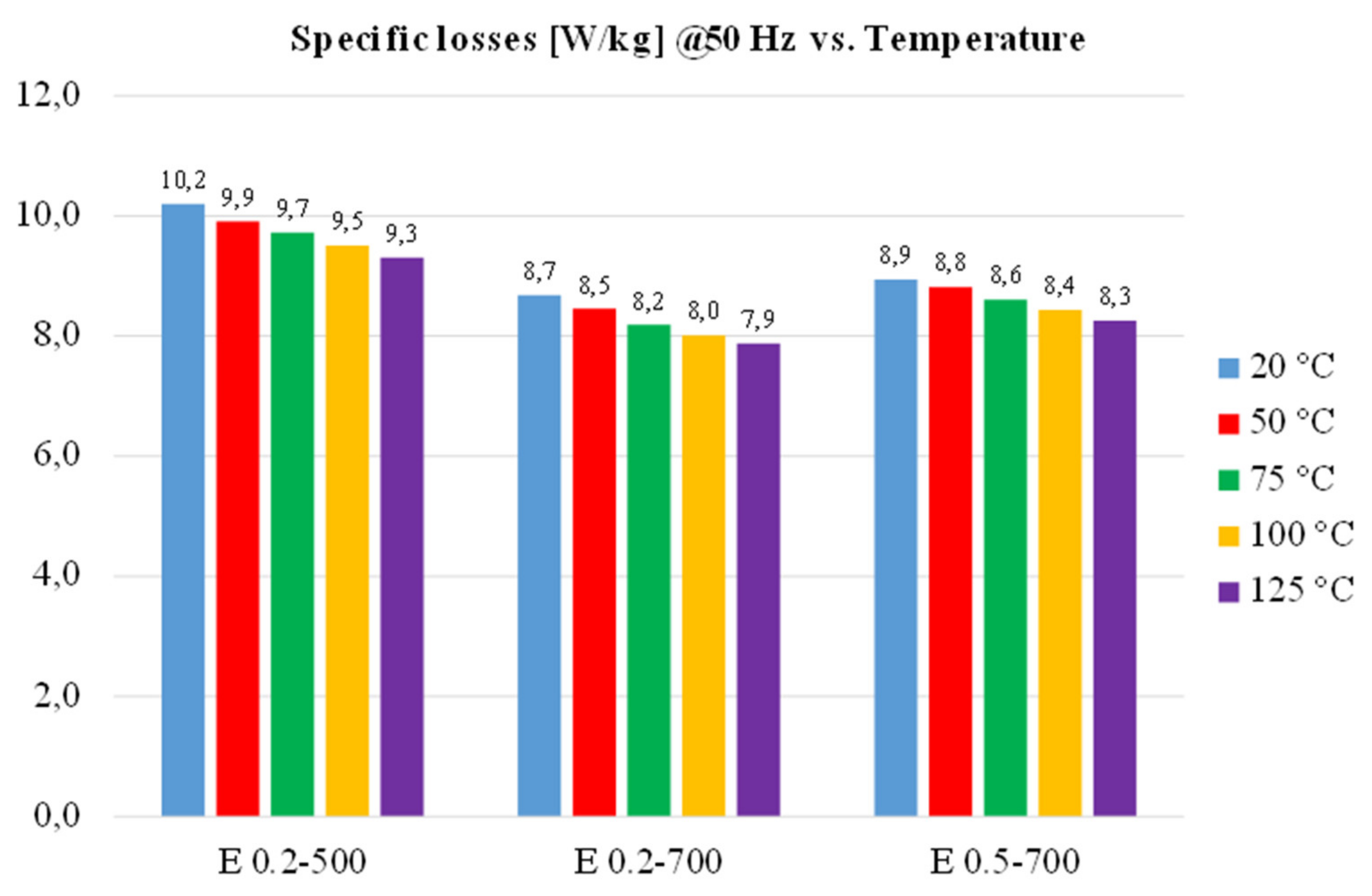
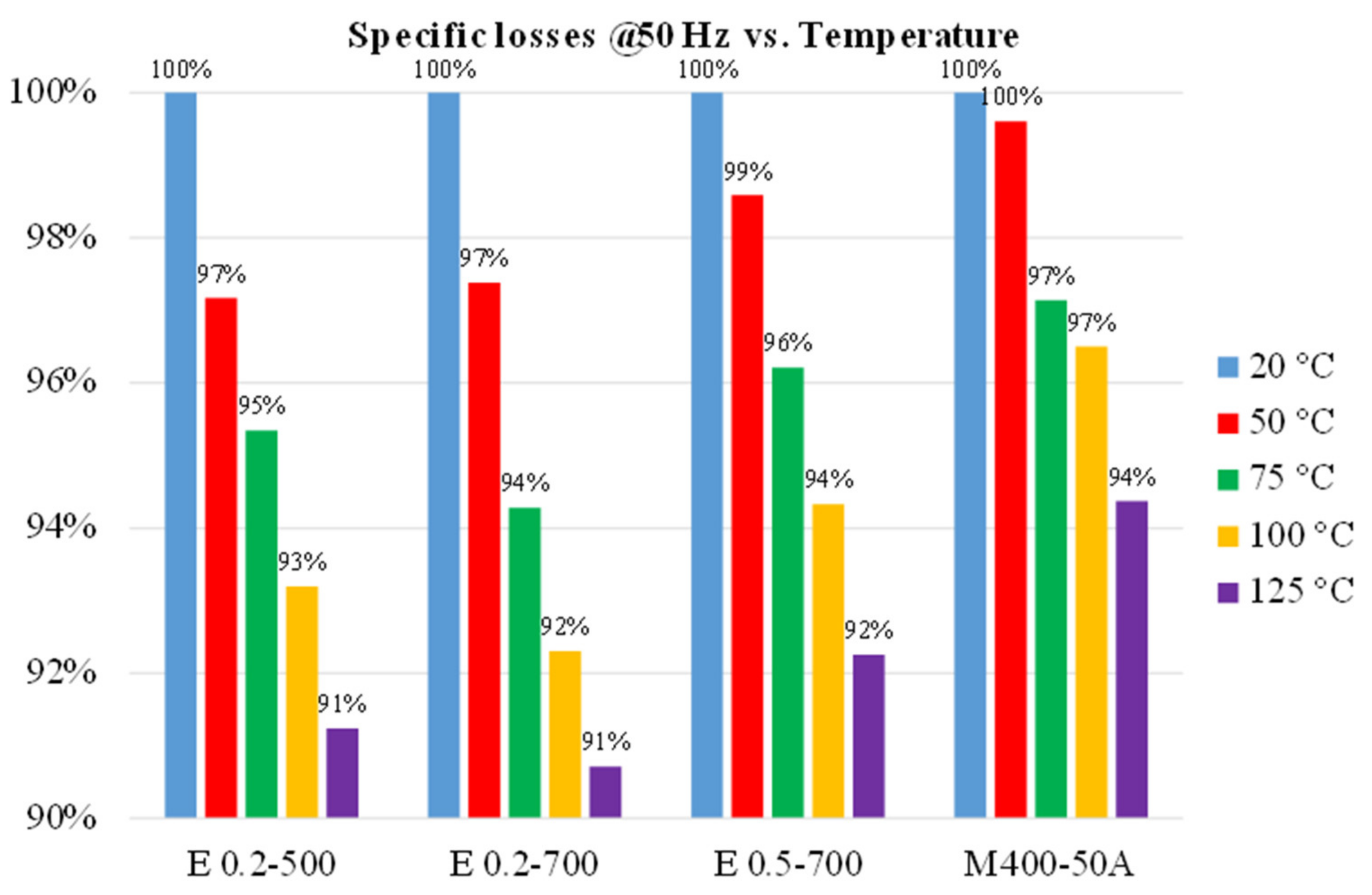
| Specimen | Binder % | Mold Pressure (MPa) | Density (g/cm3) | TRS @20 °C (MPa) |
|---|---|---|---|---|
| E 0.2-500 | 0.2% | 500 | 7.02 | 39.5 |
| E 0.2-700 | 0.2% | 700 | 7.37 | 84.5 |
| E 0.5-700 | 0.5% | 700 | 7.28 | 120.7 |
| Specific Iron Losses @ 1T (W/kg) | ||||
|---|---|---|---|---|
| Specimen Typology and Temperature | Frequency [Hz] | |||
| 50 | 400 | 500 | ||
| E 0.2-500 | 20 °C | 10.20 | 107.14 | 141.56 |
| 125 °C | 9.30 | 99.85 | 132.39 | |
| E 0.2-700 | 20 °C | 8.68 | 89.06 | 117.37 |
| 125 °C | 7.87 | 80.83 | 106.60 | |
| E 0.5-700 | 20 °C | 8.94 | 93.29 | 123.01 |
| 125 °C | 8.25 | 86.72 | 114.30 | |
| Scheme 1. T (%). | |||
|---|---|---|---|
| Specimen Typology | Frequency (Hz) | ||
| 50 | 400 | 500 | |
| E 0.2-500 | −9% | −7% | −6% |
| E 0.2-700 | −9% | −9% | −9% |
| E 0.5-700 | −8% | −7% | −7% |
| Specific Iron losses @ 1T (%) | |||
|---|---|---|---|
| Laminated Steel | Frequency (Hz) | ||
| 50 | 400 | 500 | |
| M400-50A | −6% | −7% | −7% |
Publisher’s Note: MDPI stays neutral with regard to jurisdictional claims in published maps and institutional affiliations. |
© 2021 by the authors. Licensee MDPI, Basel, Switzerland. This article is an open access article distributed under the terms and conditions of the Creative Commons Attribution (CC BY) license (https://creativecommons.org/licenses/by/4.0/).
Share and Cite
Ferraris, L.; Franchini, F.; Pošković, E.; Actis Grande, M.; Bidulský, R. Effect of the Temperature on the Magnetic and Energetic Properties of Soft Magnetic Composite Materials. Energies 2021, 14, 4400. https://doi.org/10.3390/en14154400
Ferraris L, Franchini F, Pošković E, Actis Grande M, Bidulský R. Effect of the Temperature on the Magnetic and Energetic Properties of Soft Magnetic Composite Materials. Energies. 2021; 14(15):4400. https://doi.org/10.3390/en14154400
Chicago/Turabian StyleFerraris, Luca, Fausto Franchini, Emir Pošković, Marco Actis Grande, and Róbert Bidulský. 2021. "Effect of the Temperature on the Magnetic and Energetic Properties of Soft Magnetic Composite Materials" Energies 14, no. 15: 4400. https://doi.org/10.3390/en14154400
APA StyleFerraris, L., Franchini, F., Pošković, E., Actis Grande, M., & Bidulský, R. (2021). Effect of the Temperature on the Magnetic and Energetic Properties of Soft Magnetic Composite Materials. Energies, 14(15), 4400. https://doi.org/10.3390/en14154400








